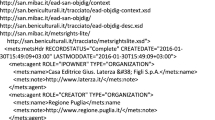Abstract
This research covers the digital preservation concept and the terms around this definition. According to this contextualization it is related with the management of data in the different fields but with the same issues and concerns. The appropriate way to keep information through the time is with preservation parameters. The managing of massive amounts of critical data involves designing, modeling, processing and implementation of accurate system. The methods for the treatment of data have to consider two dimensions that this chapter has focused: access dimension and cognitive dimension. Both of them have relevance to get results because at the same time, ensure the correct data preservation. On the other side data management has to consider digital resources and digital artefacts and how they affect the process of preservation. In this chapter there are approaches with other authors referencing current and future studies. This chapter has been organized as follow. First in the introduction we can find ideas about the types of data in the different fields nowadays. Second, the main part, the proposal of methods in reference with other authors. Finally the conclusions and future projects based on the findings. This study focus on the development of framework, beginning with the methodology and projected through the application of specific patterns such a model for sustainable solution.
Access this chapter
Tax calculation will be finalised at checkout
Purchases are for personal use only
Similar content being viewed by others
References
Adak, S., et al.: A system for knowledge management in bioinformatics. In: Proceedings of the Eleventh International Conference on Information and Knowledge Management, (2002) pp. 638–641 Virginia, ACM
Bathurst, http://www.bathurst.nsw.gov.au/building-and/heritage/what-is-heritage.html
Castelli, D., et al.: Open knowledge on e-Infrastructures: the BELIEF project Digital Library. IST-Africa (2010)
Chandras, C., et al.: Digital preservation—financial sustainability of biological data and material resources. In: 8th IEEE International Conference on BioInformatics and BioEngineering (BIBE) (2008)
Challa, S., Gulrez, T., Chaczko, Z., Paranesha, T.N.: Opportunistic information fusion: a new paradigm for next generation networked sensing systems. In: 8th International Conference on Information Fusion, vol. 1, p. 8 (2005)
Doyle, J., et al.: Long-term digital preservation: preserving authenticity and usability of 3-D data. Int. J. Digit. Libr. 10(1), 33–47 (2009)
Engelsman, W., Jonkers, H., Quartel, D.: ArchiMate\(\textregistered \) extension for modeling and managing motivation, principles, and requirements in TOGAF\(\textregistered \). White Paper, The Open Group (2011)
Kaner, M., Karni, R.: A capability maturity model for knowledge-based decisionmaking. Inf. Knowl. Syst. Manag. 4(4), 225–252 (2004)
Strodl, S., et al.: How to choose a digital preservation strategy: evaluating a preservation planning procedure. In: Proceedings of the 7th ACM/IEEE-CS Joint Conference on Digital Libraries. pp. 29–38. Vancouver, ACM (2007)
UNESCO. Information Document Glossary of World Heritage Terms. http://whc.unesco.org/archive/gloss96.htm (1996)
Weaver, R., et al.: Maintaining data records: practical decisions required for data set prioritization, preservation, and access. In:IEEE International Geoscience and Remote Sensing Symposium (IGARSS) (2008)
Author information
Authors and Affiliations
Corresponding author
Editor information
Editors and Affiliations
Rights and permissions
Copyright information
© 2015 Springer International Publishing Switzerland
About this chapter
Cite this chapter
Gordon, L.C., Chaczko, Z. (2015). Digital Patterns for Heritage and Data Preservation Standards. In: Borowik, G., Chaczko, Z., Jacak, W., Łuba, T. (eds) Computational Intelligence and Efficiency in Engineering Systems. Studies in Computational Intelligence, vol 595. Springer, Cham. https://doi.org/10.1007/978-3-319-15720-7_4
Download citation
DOI: https://doi.org/10.1007/978-3-319-15720-7_4
Published:
Publisher Name: Springer, Cham
Print ISBN: 978-3-319-15719-1
Online ISBN: 978-3-319-15720-7
eBook Packages: EngineeringEngineering (R0)




